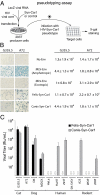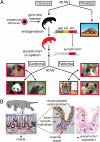Ancestral capture of syncytin-Car1, a fusogenic endogenous retroviral envelope gene involved in placentation and conserved in Carnivora
- PMID: 22308384
- PMCID: PMC3289388
- DOI: 10.1073/pnas.1115346109
Ancestral capture of syncytin-Car1, a fusogenic endogenous retroviral envelope gene involved in placentation and conserved in Carnivora
Abstract
Syncytins are envelope protein genes of retroviral origin that have been captured for a function in placentation. Two such genes have already been identified in simians, two distinct, unrelated genes have been identified in Muridae, and a fifth gene has been identified in the rabbit. Here, we searched for similar genes in the Laurasiatheria clade, which diverged from Euarchontoglires--primates, rodents, and lagomorphs--shortly after mammalian radiation (100 Mya). In silico search for envelope protein genes with full-coding capacity within the dog and cat genomes identified several candidate genes, with one common to both species that displayed placenta-specific expression, which was revealed by RT-PCR analysis of a large panel of tissues. This gene belongs to a degenerate endogenous retroviral element, with precise proviral integration at a site common to dog and cat. Cloning of the gene for an ex vivo pseudotype assay showed fusogenicity on both dog and cat cells. In situ hybridization on placenta sections from both species showed specific expression at the level of the invasive fetal villi within the placental junctional zone, where trophoblast cells fuse into a syncytiotrophoblast layer to form the maternofetal interface. Finally, we show that the gene is conserved among a series of 26 Carnivora representatives, with evidence for purifying selection and conservation of fusogenic activity. The gene is not found in the Pholidota order and, therefore, it was captured before Carnivora radiation, between 60 and 85 Mya. This gene is the oldest syncytin gene identified to date, and it is the first in a new major clade of eutherian mammals.
Conflict of interest statement
The authors declare no conflict of interest.
Figures











Comment in
-
Retroviruses push the envelope for mammalian placentation.Proc Natl Acad Sci U S A. 2012 Feb 14;109(7):2184-5. doi: 10.1073/pnas.1121365109. Epub 2012 Jan 26. Proc Natl Acad Sci U S A. 2012. PMID: 22308481 Free PMC article. No abstract available.
Similar articles
-
Capture of syncytin-Mar1, a fusogenic endogenous retroviral envelope gene involved in placentation in the Rodentia squirrel-related clade.J Virol. 2014 Jul;88(14):7915-28. doi: 10.1128/JVI.00141-14. Epub 2014 Apr 30. J Virol. 2014. PMID: 24789792 Free PMC article.
-
Retroviral envelope syncytin capture in an ancestrally diverged mammalian clade for placentation in the primitive Afrotherian tenrecs.Proc Natl Acad Sci U S A. 2014 Oct 14;111(41):E4332-41. doi: 10.1073/pnas.1412268111. Epub 2014 Sep 29. Proc Natl Acad Sci U S A. 2014. PMID: 25267646 Free PMC article.
-
The captured retroviral envelope syncytin-A and syncytin-B genes are conserved in the Spalacidae together with hemotrichorial placentation.Biol Reprod. 2014 Dec;91(6):148. doi: 10.1095/biolreprod.114.124818. Epub 2014 Oct 22. Biol Reprod. 2014. PMID: 25339103
-
From ancestral infectious retroviruses to bona fide cellular genes: role of the captured syncytins in placentation.Placenta. 2012 Sep;33(9):663-71. doi: 10.1016/j.placenta.2012.05.005. Epub 2012 Jun 12. Placenta. 2012. PMID: 22695103 Review.
-
Paleovirology of 'syncytins', retroviral env genes exapted for a role in placentation.Philos Trans R Soc Lond B Biol Sci. 2013 Aug 12;368(1626):20120507. doi: 10.1098/rstb.2012.0507. Print 2013 Sep 19. Philos Trans R Soc Lond B Biol Sci. 2013. PMID: 23938756 Free PMC article. Review.
Cited by
-
A novel human endogenous retroviral protein inhibits cell-cell fusion.Sci Rep. 2013;3:1462. doi: 10.1038/srep01462. Sci Rep. 2013. PMID: 23492904 Free PMC article.
-
Cell-Cell Fusion Mediated by Viruses and HERV-Derived Fusogens in Cancer Initiation and Progression.Cancers (Basel). 2021 Oct 26;13(21):5363. doi: 10.3390/cancers13215363. Cancers (Basel). 2021. PMID: 34771528 Free PMC article. Review.
-
The Structural, Functional and Evolutionary Impact of Transposable Elements in Eukaryotes.Genes (Basel). 2021 Jun 15;12(6):918. doi: 10.3390/genes12060918. Genes (Basel). 2021. PMID: 34203645 Free PMC article. Review.
-
Viral Symbiosis in the Origins and Evolution of Life with a Particular Focus on the Placental Mammals.Results Probl Cell Differ. 2020;69:3-24. doi: 10.1007/978-3-030-51849-3_1. Results Probl Cell Differ. 2020. PMID: 33263867
-
Captured retroviral envelope syncytin gene associated with the unique placental structure of higher ruminants.Proc Natl Acad Sci U S A. 2013 Feb 26;110(9):E828-37. doi: 10.1073/pnas.1215787110. Epub 2013 Feb 11. Proc Natl Acad Sci U S A. 2013. PMID: 23401540 Free PMC article.
References
-
- Mi S, et al. Syncytin is a captive retroviral envelope protein involved in human placental morphogenesis. Nature. 2000;403:785–789. - PubMed
-
- Cáceres M, Thomas JW, Thomas JW. NISC Comparative Sequencing Program The gene of retroviral origin Syncytin 1 is specific to hominoids and is inactive in Old World monkeys. J Hered. 2006;97:100–106. - PubMed
Publication types
MeSH terms
Substances
Associated data
- Actions
- Actions
- Actions
- Actions
- Actions
- Actions
- Actions
- Actions
- Actions
- Actions
- Actions
- Actions
- Actions
- Actions
- Actions
- Actions
- Actions
- Actions
- Actions
- Actions
- Actions
- Actions
- Actions
- Actions
- Actions
- Actions
LinkOut - more resources
Full Text Sources
Other Literature Sources
Miscellaneous

